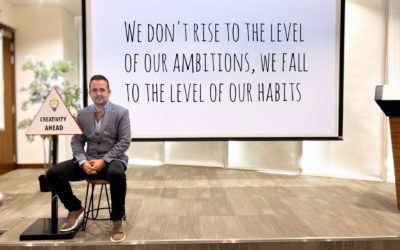What are the Basic Concepts of AI That Modern Leaders Should Understand and Why is it Important for Them to Stay Up to Speed, Even If They Are Not Technical? Estimated reading time: 8 minutes Understanding AI Fundamentals: Essential for informed decision-making. Key...
What’s the Role of Foresight in Modern Decision-Making and How Can Leaders Gain This Skill?
Estimated Reading Time: 5 minutes
- Strategic foresight is essential for anticipating and creating future opportunities, enabling proactive rather than reactive decision-making (OECD), (BCG), (Future of Retail).
- Leaders can cultivate foresight by focusing on scenario planning, engaging in environmental scanning, and embedding foresight practices into ongoing strategic processes (MentorCliq), (Future of Retail).
- Success lies in a holistic, iterative approach that connects foresight insights to concrete actions, allowing organizations to adapt continuously to new information (OECD), (BCG).
Table of Contents
- The Role of Foresight in Modern Decision-Making
- How Leaders Can Gain and Apply Strategic Foresight
- Key Takeaways for Leaders
- FAQ
The Role of Foresight in Modern Decision-Making
Anticipating Change and Building Resilience
Strategic foresight is paramount for organizations aiming to navigate the unpredictable nature of contemporary markets. By anticipating future developments and detecting weak signals of disruption, leaders can adapt their strategies proactively. Unlike traditional forecasting—which often relies on linear projections and historical data—foresight explores alternative futures. This forward-thinking approach equips decision-makers with the insights necessary to prepare for unexpected events and capture emerging opportunities (BCG), (Future of Retail).
Enhancing Strategic Agility
Strategic foresight enhances an organization’s agility by allowing leaders to engage in scenario planning and environmental scanning. These methodologies enable decision-makers to assess the long-term impacts of current trends across various domains—political, economic, social, technological, legal, and environmental (Future of Retail). As organizations develop robust contingency plans, they become better equipped to pivot and remain responsive in the face of changes in their environment (BCG).
Systemic and Iterative Approach
Effective foresight isn’t a one-off endeavor; it requires a systemic and iterative approach that integrates foresight practices into organizational functions and decision-making mechanisms. By embedding foresight into the fabric of their organizations, businesses can bridge the gap between foresight expertise and tangible outcomes (OECD). Foresight should not be considered an isolated function, but rather a core element of strategic planning and operations.
Illustrative Industry Examples
Foresight in action can be observed in several industries:
– Pharmaceuticals: Novo Nordisk utilized strategic foresight to identify the potential of GLP-1 medications early on, allowing the company to secure a leading market position (BCG).
– Industrial Manufacturing: Siemens exemplifies how foresight can lead to revenue growth by pivoting toward smart infrastructure solutions, emphasizing the importance of adaptability in a changing technological landscape (BCG).
How Leaders Can Gain and Apply Strategic Foresight
Developing Future-Oriented Thinking
To harness the power of foresight, leaders must cultivate a habit of thinking beyond the immediate challenges they face. This involves envisioning how current decisions might impact multiple future scenarios. Leaders should consider questioning their assumptions, avoiding biases, and exploring unasked questions about the future (MentorCliq), (OECD).
Scenario Planning and Environmental Scanning
A core tool for developing foresight is scenario planning. Leaders should practice mapping out alternative futures driven by different factors of change and evaluate how their organization would respond in each situation (MentorCliq). Complementary to this, environmental scanning involves analyzing external factors—such as technological innovations, demographic trends, and regulatory shifts—that provide valuable insights for decision-making (Future of Retail).
Embedding Foresight into Decision Processes
For foresight to be truly impactful, it must be woven into the organization’s regular strategic processes. Leaders can ensure ongoing foresight analysis is conducted, sharing insights across teams and linking foresight outputs directly to strategy development and implementation (OECD), (MentorCliq).
Learning from Experience and Collaboration
Foresight leadership is also about learning from past experiences and collaborating with diverse stakeholders. Fostering a culture of innovation and experimentation encourages leaders to remain open to feedback and adjust strategies based on new information (MentorCliq), (BCG). Continuous learning becomes critical as leaders navigate a changing landscape.
Key Takeaways for Leaders
- Strategic foresight is essential for anticipating and creating future opportunities, enabling proactive rather than reactive decision-making (OECD), (BCG), (Future of Retail).
- Leaders can cultivate foresight by focusing on scenario planning, engaging in environmental scanning, and embedding foresight practices into ongoing strategic processes (MentorCliq), (Future of Retail).
- Success lies in a holistic, iterative approach that connects foresight insights to concrete actions, allowing organizations to adapt continuously to new information (OECD), (BCG).
FAQ
1. What is strategic foresight?
Strategic foresight is the ability to anticipate future developments and create plans to adapt to change, enabling organizations to thrive in uncertain environments.
2. How can leaders develop foresight?
Leaders can develop foresight through scenario planning, environmental scanning, and incorporating foresight into regular decision-making processes.
3. Why is foresight important for organizations?
Foresight is crucial because it helps organizations anticipate changes, respond effectively to disruptions, and seize emerging opportunities.
In conclusion, strategic foresight empowers leaders to navigate complexity and uncertainty, fostering informed decision-making and positioning their organizations for long-term success in an unpredictable world (OECD), (MentorCliq), (BCG).
As you navigate your organizational challenges and opportunities, consider how strategic foresight can enhance your decision-making processes. For more insights on how Inspire Limitless can assist your organization in embedding foresight practices or any other aspects of innovation and digital transformation, feel free to reach out via email at marc@inspirelimitless.com or call directly at +971 58 526 7209. Let’s inspire limitless possibilities together.








